WOOD PROJECT PLANSDOWNLOADABLE & MAIL-DIRECT
WOODWORKING PLANSDownload WOOD Store® woodworking plans directly to your computer and start building in just minutes! OR, we'll mail them to you, your choice!

CLICK!
This Months Woodworking Project
Bathroom Cabinet, Step 2

Last month we built the base to our bathroom cabinet, this month we build the cabinet and complete this project. I made the cabinet out of clear pine and 1/4" plywood. We'll begin by cutting the sides 9" X 38" X 3/4".
There will be one shelf that is dadoed into the sides. Set up a 3/4" dado blade in your tablesaw to cut a dado 3/8" deep.
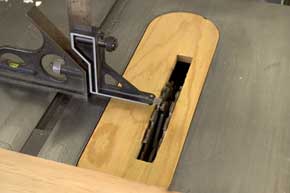
The shelf will be 5 3/4" from the bottom. Set a stop on the miter fence and cut the dado's all the way through.
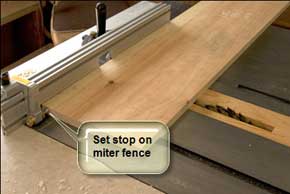
I cut them all the way through because I'm going to paint my cabinet and they won't show. If you are going to use a stain finish you may want to stop short of the front and chisel out the dado.
The sides are held to the top and bottom by biscuit joints. Lay out for three biscuits on each end marking both sides at the same time.
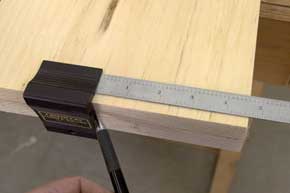
Cut in the biscuits on the top and bottom of both sides.
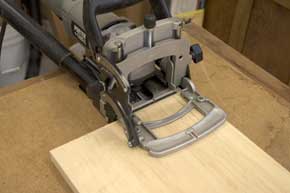

Porter-Cable Deluxe Biscuit Joiner, Model No. 557
The back of the cabinet will be 1/4" plywood so we need to dado in the backs of the sides to recess the back.
I attached a piece of scrap wood to the tablesaw fence and set the dado blade to 1/4" deep and 3/8" wide.
Mark the beginning and end of the dado blade on the fence. Use this to align your start and stop points on the side.
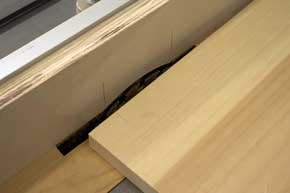
Use a chisel to complete the dado cut, squaring the ends.
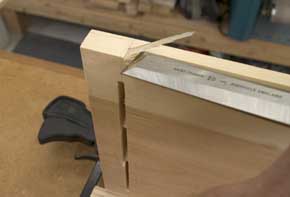
I used my shelving jig to drill the holes for the shelf holes.
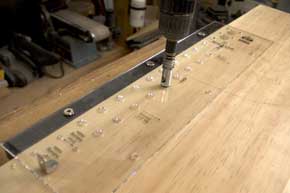

JIG IT® Shelving Jig
Cut the shelf that fits in the dado's 8 7/8" X 24 1/4".
Cut the top and bottom 10" X 26 1/2".
Round over the front and side edges of the bottom with a 3/4" Roundover bit.

Roundover/Beading Bit Set
Add a crown molding around the top front and sides. There is a large selection of different styles available at most home supply stores.
Dado the backs of the top and bottom the same as the sides to fit the 1/4" plywood back.
Align the backs of the top and bottom with the backs of the shelves and mark the centers for the biscuits.
The cabinet is now ready to glue up. Glue the biscuits, their pockets, the shelf ends and the dado it goes in. Work quickly before the glue starts to set up or use a slow drying glue.

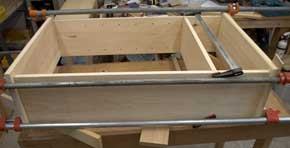
Use pipe clamps with cauls. Measure from corner to corner to make sure that it is square, then let the glue dry overnight.
I cut the back out of 1/4" plywood to fit inside the dado's I'd cut. Apply glue to the edges and nailed it in place. I did sand the inside of it first to make finishing easier later on.
Now it's time to make the doors. I decided to use lap joints for the corners. I was after an old fashion look and square corner joints seemed to fit the ticket. Each door will be 30" X 12 1/2" and made from 3/4" clear pine and plywood.
Start out by cutting the rails and stiles 30" X 1 1/2" and 12 1/2" X 1 1/2".
Using a dado cut a 1 1/2" lap joint 3/4" deep on each end.
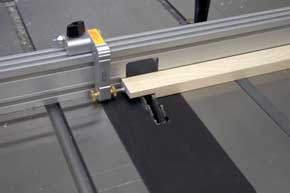
I used a stop on my miter fence to make repeatability easy.
I cut a 1/4" dado down the middle of each rail and stile to hold the 1/2" plywood.
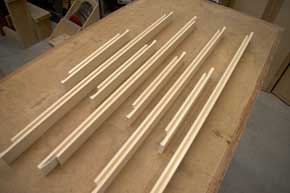
Notice that I stopped just short of the end of each piece. This saved me from having to chisel out each corner.
Cut 1/4" plywood to fit inside the frame.
Glue only the corners, not inside the dado for the plywood. You want the plywood to be able to float with weather changes.
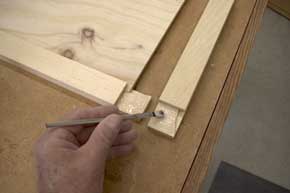
Work quickly so the glue does not dry and clamp each corner.

Be sure to check the squareness of each door by measuring from corner to corner. The dimension should be the same.
For hinges I decided on non-mortise hinges.

Non-Mortise Hinges
Even though they are non-mortise hinges I decided to inset them a little. I used my plunge router and clamped a piece of wood on each side for stability and routed a mortise on the cabinet side.
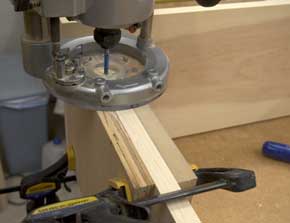

Porter-Cable 893PK Router Package
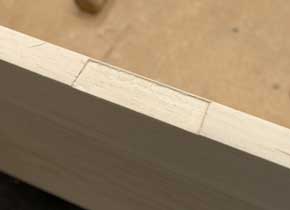
While I didn't get any good photos of the next few steps they are pretty straight forward.

I cut a 1/4" piece of plywood to fit exactly between the rails of the doors approximately 7" high.
Glue and clamp this piece in place.
Cut the fake drawer fronts from 1/2" clear pine 4 1/2" X 10 1/2".
Round over all four sides with a 1/2" Roundover bit.
Glue these centered and flush to the top of the bottom stile.
Now add the trim strips. I made them from 1/4" X 1/2" clear pine. Round over the edges with a 1/8" Roundover bit.
Cut four of them to fit the width of the door plus 1/4" to allow for the miter on one end. Miter one end 45 degrees.
Cut the tiny end pieces to fit the edge of the door plus 1/4". Miter both ends 45 degrees but in opposite directions as shown.
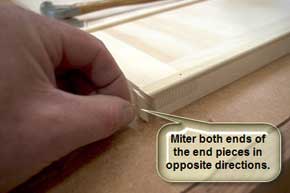
Glue and nail the trim strips with finish nails.
Apply your finish of choice to the cabinet and it's ready to mount to the base.
Drill holes for the pulls that go on the cabinet doors and fake drawer fronts. A little trick I like to use is a sticky note to lay out the lines for drilling.
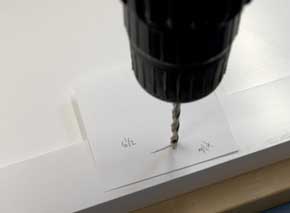
I used figure eight fasteners to hole the cabinet to the base.
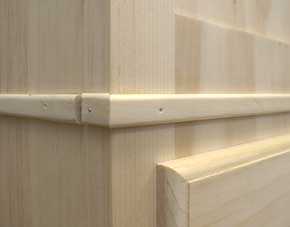

Desk Top Fasteners
Drill countersink holes with a Forestner bit so the figure eight fastener is flush to the top.

Screw in the figure eight fasteners with flat head screws.

Set the cabinet on top of the base and screw up through the figure eight fasteners.
Cut and paint some shelves to fit inside the cabinet and you are good to go.
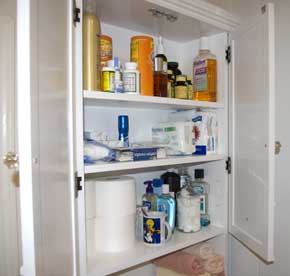
Since this cabinet has a small base it should be attached to the wall for stability. |